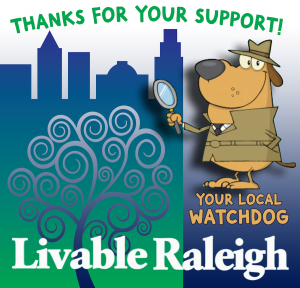
Michael Sutton describes himself as “just a citizen in east Raleigh.” He recently agreed to share the following comments on TODs (Transit Overlay Districts) that he sent to the City Council for their consideration.
Dear City Council:
Nearly twenty years ago, I dropped off a friend at a car repair shop on Glenwood Avenue. The brand-new Helios Coffee Shop next door caught my attention because, at just two-stories, it stood above its neighbors on the 400 block of Glenwood. It signaled the beginning of something exciting and new.
This week, the “Safe, Vibrant & Healthy Communities Committee” has Glenwood South on its agenda due to the increase of crime. The entertainment district has become the city hot spot for assaults, larceny, and now even murder.
As we look back at the changes of Glenwood Avenue over these past twenty years, it would be wise to reflect on the decisions that created this Frankenstein monster that can no longer be controlled. The Glenwood entertainment district did not just pop up organically, it was nurtured through rezoning.
This is of particular importance when we consider the major rezoning of east Raleigh occurring through the Transit Overlay District (TOD). One of the smaller, but just as significant pieces of this rezoning petition by the City is to rezone 30 properties in the Oakwood HOD and the New Bern-Edenton NCOD to the “DX” designation.
This is significant because the “DX” mixed-use zoning designation has among its permitted uses “bars, nightclubs, and taverns.” This is the same zoning designation as Glenwood South and City Planners intend to extend those permitted uses into the Oakwood and Hungry Neck neighborhoods.
The implications of this rezoning have fallen on deaf ears with City of Raleigh Planning. They claim that the TOD rezoning is about creating affordable housing, but some of the most affordable rental units are included in these properties. These properties also include the Helping Hand Mission’s New Bern House for Seniors and the Emmaus House that provides transitional and affordable housing to men recovering from addiction.
The idea that the City of Raleigh would rezone properties that include and surround an addiction transitional home to permit bars, clubs, and taverns is nothing short of offensive. What other neighborhood in Raleigh do you know that is willing to embrace them? These are our neighbors! And they have been good neighbors.
Please let the lessons being learned this year from the neighborhoods surrounding Glenwood South inform this rezoning process. Extending the downtown intense mixed-use entertainment district into the neighborhoods of east Raleigh will not result in safe, vibrant, or healthy communities. As Glenwood South has shown, the crime issues will only spill further into the surrounding neighborhoods.
At the August Planning Committee of the Whole, former City Council Member Russ Stephenson suggested that the TOD rezoning is too large as a whole to consider its implications in one project and recommended passing the needed and uncontroversial rezoning east of the beltline and study the impact of the BRT (Bus Rapid Transit) before rezoning the portion closer to town that involves historic and diverse neighborhoods. This small, but significant rezoning of the Oakwood and Hungry Neck properties to become part of the downtown entertainment district is just one of many examples of how the TOD rezoning process is too large to give significant attention to all of the 700 plus properties being rezoned. Our neighborhoods deserve focused attention.
Michael Sutton
East Edenton Street
You can read a previous piece by Michael Sutton here: Scale Matters
BRT is Bus Rapid Tansit. You can read more here: What is BRT (Bus Rapid Transit)?
If you appreciate the kind of reporting we bring to you
|
Please donate $10 or $20, Thanks for supporting |
 |

